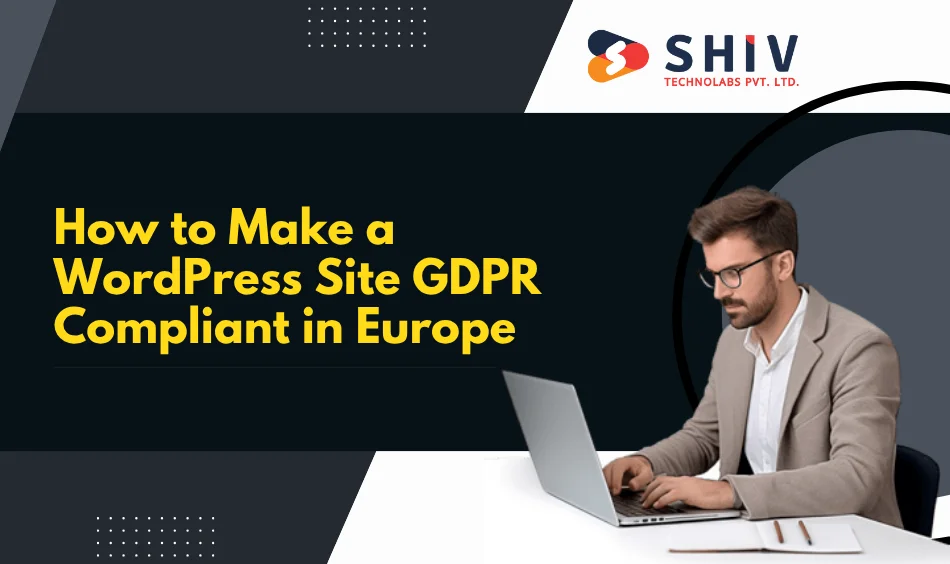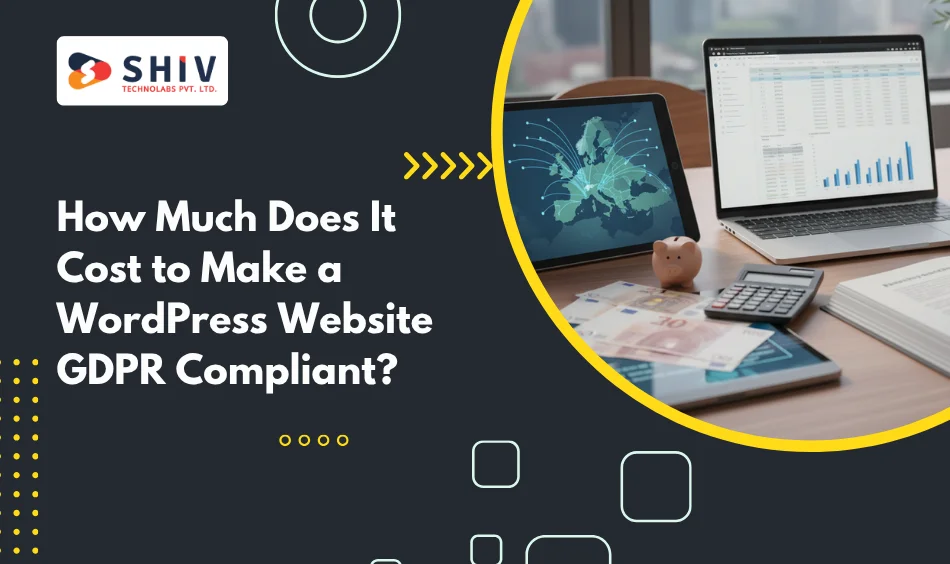Table of Contents
If your business runs on WordPress, GDPR shapes how you sell, support, and advertise across Europe. Customers want simple choices, quick answers, and honest handling of data across forms, pixels, and checkout. With custom wordpress development services in Europe , you can add consent controls and safer flows without hurting conversions or reporting.
Regulators issue fines, but the bigger threat is trust that fades after confusing cookie banners and vague policies. Partners run checks as well; payment providers and marketplaces review privacy setup before approving campaigns or upgrades. Strong WordPress GDPR compliance in Europe protects revenue channels and keeps your brand credible during busy seasons.
Treat privacy like a product feature that supports growth rather than blocking it across teams. Clear notices, readable policies, and respectful defaults make people more willing to register, buy, and return. This guide turns WordPress GDPR compliance into practical steps your staff can run without guesswork.
Start with a short audit that maps cookies, pixels, forms, data rights, and vendor sharing across templates. Define lawful bases, shorten retention, and add consent logs that match your ads, analytics, and email stacks. Our specialists configure consent modes, safer defaults, and clear notices while preserving reporting quality for growth.
What Is WordPress GDPR Compliance and Why Does It Matter in Europe?
WordPress GDPR compliance aligns tracking, forms, storage, and vendors with European privacy law across real user journeys. It converts legal duties into settings, records, and consent flows that teams can operate, test, and improve.
Because WordPress relies on plugins and external scripts, small changes can ripple through cookies and consent logic. A structured plan maps each plugin’s behavior, sets lawful bases, and adds monitoring that flags risky updates early. For e-commerce stores, tighten checkout and catalog flows with WooCommerce development to keep tracking in check.
What does GDPR mean for WordPress website owners?
GDPR is an EU law that governs how websites collect, use, share, and store personal data. It focuses on transparency, user control, and security across contact forms, analytics, ads, and support tools. Site owners publish clear notices, gather explicit consent for non-essential cookies, and keep verifiable records.
People can access, correct, delete, or download their data, and they can withdraw consent at any time. Your team responds within set timelines and shows proof that choices were respected across systems and vendors.
Why is GDPR compliance critical for European businesses?
Compliance protects reputation, partner access, and sales when banks, ad platforms, or marketplaces review your setup. Weak banners, silent tracking, or vague notices invite penalties, refunds, and public reports that strain growth.
- Legal obligations for businesses
- Data collection transparency
- Customer consent requirements
- Cross-border data rules
Publish a clear policy, wire consent into pixels and forms, and keep evidence that requests received timely responses. These habits shorten audits, reduce disputes, and reassure buyers that your brand treats personal information with care.
How to Make a WordPress Site GDPR Compliant in Europe

Here is how to make WordPress site GDPR compliant in Europe without hurting sales or speed. Start with a clear plan that maps cookies, forms, vendors, and data flows across templates.
WordPress data protection Europe expects lawful bases, transparent notices, and working tools for user rights. Document each purpose, limit retention, and add consent logs that auditors and partners can verify quickly.
Assign a data lead who tracks vendors, incident handling, and records of processing activities each quarter. Use a simple register that links each purpose to the lawful basis, retention period, and processors.
What are the core steps to achieve GDPR compliance on WordPress?
These steps give your team a practical path from audit to launch and ongoing reviews. Keep changes small, test often, and record choices so you can answer questions with confidence.
- Add cookie consent banners that block non-essential scripts until visitors grant clear, specific permission first.
- Update privacy policy pages with lawful bases, processors, retention windows, and contact details for requests.
- Implement data access and deletion requests with tracked tickets, deadline reminders, and verification to prevent abuse.
- Encrypt contact forms and stored user data using HTTPS, strong ciphers, and server-side field controls.
- Review plugins for GDPR readiness, removing risky scripts and replacing unsupported features with safer alternatives; where needed, ship safer logic through custom WordPress plugins.
Run test journeys for signup, checkout, and contact forms with cookies blocked and consent withdrawn. Confirm that non-essential tags stay off, emails stop, and data requests reach the right owner. Document results with screenshots and timestamps for faster reviews during audits and partner checks later.
Which WordPress GDPR compliance features are essential for business websites?
Certain features help WordPress business sites keep privacy rules visible, workable, and easy to review later. Use them from day one, and fold them into your theme, consent logic, and admin routines.
- Consent management tools that gate tags, support granular choices, and log proof for every decision.
- User data export and delete features that respect identity checks and give status updates promptly.
- Secure form submissions with spam controls, file scanning, and encryption from browser to database storage.
- Cookie policy banners that load quickly, match your design, and store records for audit reviews.
- Privacy policy integration across footers, menus, and checkout to keep rights visible during key actions.
- Third-party plugin compliance checks that test updates, tag behavior, and data sharing after each release – use WordPress development support to keep updates steady and safe.
Avoid dark patterns that pressure consent or hide choices behind extra clicks or confusing layouts. Keep refusal as easy as acceptance, and let visitors change settings from every page quickly. Test colors and copy for clarity, not trickiness, then measure consent rates by channel regularly.
Show localized banners and policies for visitors across the European Economic Area, including language and currency differences. Use regional settings to respect local consent rules in France, Germany, Italy, Spain, and other markets.
Set a monthly routine that reviews banners, policies, and integrations after major theme or plugin releases. Use a short checklist during releases to avoid regressions and keep consent logic working across pages. If you need help, our specialists can configure settings and train staff for reliable daily routines.
What Tools and Plugins Help Achieve WordPress GDPR Compliance?
Short answer: pick reliable consent, forms, and analytics tools, then test updates on staging before going live. Your goal is clear choices, safe data handling, and records that auditors can review quickly.
We set banners to block non-essential scripts until visitors agree, then log that choice with a timestamp and ID. We also tune analytics for IP masking, consent modes, and safer defaults that respect regional rules across Europe.
| Plugin Name | Key Feature | Suitable For | GDPR Support |
|---|---|---|---|
| CookieYes | Cookie consent and banner management | All sites | ✅ |
| Complianz | Full GDPR toolkit | E-commerce | ✅ |
| WPForms | GDPR-ready contact forms | SMEs | ✅ |
| MonsterInsights | Anonymized analytics tracking | Business sites | ✅ |
| WP GDPR Compliance | One-click privacy controls | General | ✅ |
CookieYes or Complianz handle region rules, granular choices, and consent logs with export options. WPForms secures contact, quote, and support flows, while disabling extras that create unnecessary data. MonsterInsights applies IP masking and consent modes, and WP GDPR Compliance gives smaller teams quick privacy switches.
We connect every plugin to a simple evidence trail that shows who changed what and when. Screenshots, version notes, and test passes live in a shared folder, so partner checks move faster. If your team wants help, we install, configure, and document everything in plain language for admins and reviewers.
How Much Does It Cost to Make a WordPress Website GDPR Compliant?

Short answer: cost depends on site size, data flows, and the level of automation your team wants. Most projects fit into clear ranges, and focused work prevents repeat fixes after audits or plugin releases.
What factors affect the cost of WordPress GDPR compliance in Europe?
Project scope grows with more templates, vendors, and data types across your stack. Plan for the items below, then pick the steps that cut risk fastest while keeping conversions steady.
- Website size and data volume
- Plugin and integration requirements
- Custom functionality and automation
- Legal consulting and audits
Typical GDPR compliance cost range for WordPress websites
These ranges cover software setup, consent logic, documentation, and validation that partners commonly request. Numbers vary by industry and language count, but they give a practical starting point for EU-facing sites.
| Business Type | Approx. Cost (EUR) | Key Inclusions |
|---|---|---|
| Small Business | €800 – €1,500 | Policy setup, cookie tool, consent forms, analytics consent mode |
| E-commerce | €1,500 – €3,500 | Checkout consent flows, cookie banner, user rights automation, vendor review |
| Large Enterprise | €3,500 – €7,000+ | Advanced processing maps, audits, multi-language setup, regional variants |
For planning, reference this broader WordPress website cost guide to align scope and budgets with stakeholders.
Custom work reduces long-term cost by matching consent, forms, and vendors to your exact stack. You avoid breakage after theme or plugin updates and keep campaigns running during peak seasons. Our team scopes the tasks, implements changes, and leaves you with simple routines that stand up during reviews.
Why Choose Custom WordPress Development for GDPR-Compliant Websites?
Custom builds match your real data flows, so controls work across forms, pixels, and checkout without gaps. This approach supports WordPress data protection Europe by aligning consent logic, server rules, and vendor behavior with your stack.
How do custom-built solutions provide better data protection?
Our team adds server-side encryption, strict cookie gating, and safer defaults that stop risky scripts before consent. We also tune logs, retention, and audit trails, so partners can review choices quickly during approvals.
How does a development team integrate GDPR during the build process?
We map journeys, list every data touchpoint, and link consent choices to exact tags, forms, and vendors. Then we ship the work in short sprints and record settings that auditors and platforms can check fast.
- Legal compliance consultation
- Data storage strategy
- Integration of consent APIs
- GDPR plugin configuration
- Privacy-first UI/UX setup
What are the long-term advantages of custom GDPR-compliant development?
You avoid repeated fixes after theme or plugin releases because privacy rules sit inside core templates. You also cut risk from shadow scripts, keep records clean, and protect growth during high-traffic seasons. If you want a hands-on partner, hire dedicated WordPress developers to maintain and improve your stack.
Common Mistakes Businesses Make With WordPress GDPR Compliance
Many teams publish banners that fail to block non-essential scripts until visitors agree. Others post vague policies, skip consent logs, or forget regional variants for key European languages and rules.
- Using outdated plugins
- Not updating privacy policy
- Failing to log consent records
- Ignoring multi-language cookie banners for EU visitors
Tip: Test your GDPR settings with online scanners and manual journeys before launch. Save screenshots and timestamps to speed partner reviews later.
How European Businesses Can Stay Updated With Changing GDPR Rules
Guidance evolves, so privacy settings need simple routines that keep pace without hurting funnels. Track vendor changes, test releases on staging, and document results with clear notes your team can reference.
- Schedule quarterly plugin reviews
- Monitor EU legal updates
- Perform GDPR audits annually
Why Businesses Should Invest in Professional GDPR-Ready WordPress Development
Choose Shiv Technolabs when you need WordPress GDPR compliance that protects growth, speeds reviews, and keeps partners confident across Europe. Our team maps data flows, configures consent, and documents every setting, so audits pass faster and campaigns keep momentum rolling.
We set banners to block non-essential scripts until visitors agree, and wire consent modes into analytics, ads, and forms properly. You receive clear records, version notes, and screenshots that satisfy payment providers, marketplaces, and platforms during privacy checks and approvals. Book a quick call, and Shiv Technolabs will scope tasks, align timelines, confirm costs, and prepare your site for compliance.
Conclusion
A privacy-ready WordPress site builds trust, passes reviews, and supports growth across ads, analytics, and checkout. Partnering with a trusted custom WordPress development company in Europe helps your business meet GDPR duties while keeping performance strong.
FAQs
Q1. How do I know if my WordPress website is GDPR compliant?
Run scans, consent tests, and rights checks across key journeys. Confirm banners block non-essential scripts and verify logs, timelines, and policy clarity.
Q2. What happens if my WordPress website doesn’t follow GDPR rules?
You risk fines, public reports, and partner rejections that slow campaigns and hurt sales. Customers also lose confidence when banners mislead or forms request excessive data.
Q3. Do I need a GDPR plugin if I already have a privacy policy?
Yes, because plugins handle technical tasks that a document cannot cover. They gate scripts, record consent, and route requests so teams respond on time.
Q4. How often should I review my GDPR settings on WordPress?
Check quarterly or after major theme and plugin releases that affect cookies or forms. Keep screenshots, timestamps, and version notes to speed audits and partner checks.
Q5. Can I make an existing WordPress site GDPR compliant without rebuilding it?
Yes, start with banners, encrypted forms, and clear policy updates across footers and checkout. Then add request workflows, vendor reviews, and logs that document every change and decision.























